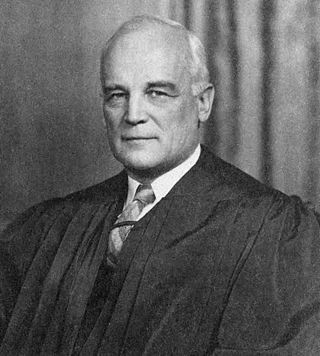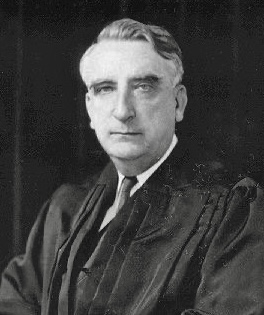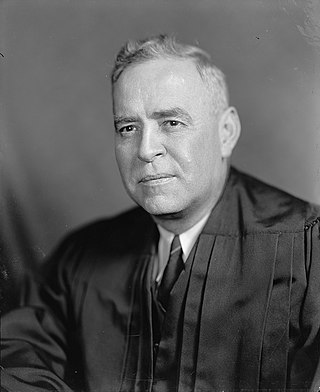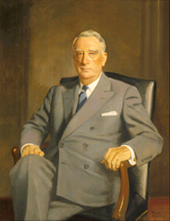
Earl Warren was an American attorney, politician, and jurist who served as the 14th Chief Justice of the United States from 1953 to 1969. The Warren Court presided over a major shift in American constitutional jurisprudence, which has been recognized by many as a "Constitutional Revolution" in the liberal direction, with Warren writing the majority opinions in landmark cases such as Brown v. Board of Education (1954), Reynolds v. Sims (1964), Miranda v. Arizona (1966), and Loving v. Virginia (1967). Warren also led the Warren Commission, a presidential commission that investigated the 1963 assassination of President John F. Kennedy. He also served as Governor of California from 1943 to 1953, and is the last chief justice to have served in an elected office before nomination to the Supreme Court. Warren is generally considered to be one of the most influential Supreme Court justices and political leaders in the history of the United States.

Hugo Lafayette Black was an American lawyer, politician, and jurist who served as a U.S. Senator from Alabama from 1927 to 1937 and as an associate justice of the U.S. Supreme Court from 1937 to 1971. A member of the Democratic Party and a devoted New Dealer, Black endorsed Franklin D. Roosevelt in both the 1932 and 1936 presidential elections.

Felix Frankfurter was an Austrian-born American jurist who served as an Associate Justice of the Supreme Court of the United States from 1939 until 1962, during which period he was a noted advocate of judicial restraint in its judgements.

William Francis Murphy was an American politician, lawyer, and jurist from Michigan. He was a Democrat who was named to the Supreme Court of the United States in 1940 after a political career that included serving as United States Attorney General, 35th Governor of Michigan, and Mayor of Detroit. He also served as the last Governor-General of the Philippines and the first High Commissioner to the Philippines.

Harold Hitz Burton was an American politician and lawyer. He served as the 45th mayor of Cleveland, Ohio, as a U.S. Senator from Ohio, and as an associate justice of the Supreme Court of the United States.

Frederick "Fred" Moore Vinson was an American attorney and politician who served as the 13th chief justice of the United States from 1946 until his death in 1953. Vinson was one of the few Americans to have served in all three branches of the U.S. government. Before becoming chief justice, Vinson served as a U.S. Representative from Kentucky from 1924 to 1928 and 1930 to 1938, as a federal appellate judge on the U.S. Court of Appeals for the District of Columbia Circuit from 1938 to 1943, and as the U.S. Secretary of the Treasury from 1945 to 1946.

Wiley Blount Rutledge Jr. was an American jurist who served as an associate justice of the Supreme Court of the United States from 1943 to 1949. The ninth and final justice appointed by President Franklin D. Roosevelt, he is best known for his impassioned defenses of civil liberties. Rutledge favored broad interpretations of the First Amendment, the Due Process Clause, and the Equal Protection Clause, and he argued that the Bill of Rights applied in its totality to the states. He participated in several noteworthy cases involving the intersection of individual freedoms and the government's wartime powers. Rutledge served on the Court until his death at the age of fifty-five. Legal scholars have generally thought highly of the justice, although the brevity of his tenure has minimized his impact on history.
Wolf v. Colorado, 338 U.S. 25 (1949), was a United States Supreme Court case in which the Court held 6—3 that, while the Fourth Amendment was applicable to the states, the exclusionary rule was not a necessary ingredient of the Fourth Amendment's right against warrantless and unreasonable searches and seizures. In Weeks v. United States, 232 U.S. 383 (1914), the Court held that as a matter of judicial implication the exclusionary rule was enforceable in federal courts but not derived from the explicit requirements of the Fourth Amendment. The Wolf Court decided not to incorporate the exclusionary rule as part of the Fourteenth Amendment in large part because the states which had rejected the Weeks Doctrine had not left the right to privacy without other means of protection. However, because most of the states' rules proved to be ineffective in deterrence, the Court overruled Wolf in Mapp v. Ohio, 367 U.S. 643 (1961). That landmark case made history as the exclusionary rule enforceable against the states through the Due Process clause of the Fourteenth Amendment to the same extent that it applied against the federal government.
Youngstown Sheet & Tube Co. v. Sawyer, 343 U.S. 579 (1952), also commonly referred to as the Steel Seizure Case or the Youngstown Steel case, was a landmark United States Supreme Court decision that limited the power of the President of the United States to seize private property. The case served as a check on the most far-reaching claims of executive power at the time and signaled the Court's increased willingness to intervene in political questions.

The Warren Court was the period in the history of the Supreme Court of the United States during which Earl Warren served as Chief Justice. Warren replaced the deceased Fred M. Vinson as Chief Justice in 1953, and Warren remained in office until he retired in 1969, at which point he was replaced by Warren Burger. The Warren Court is often considered the most liberal court in US history.

The Burger Court was the period in the history of the Supreme Court of the United States from 1969 to 1986, when Warren Burger served as Chief Justice of the United States. Burger succeeded Earl Warren as Chief Justice after the latter's retirement, and Burger served as Chief Justice until his retirement, at which point William Rehnquist was nominated and confirmed as Burger's replacement. The Burger Court is generally considered to be the last liberal court to date. It has been described as a "transitional" court, due to its transition from having the liberal rulings of the Warren Court to the conservative rulings of the Rehnquist Court.

The Ellsworth Court refers to the Supreme Court of the United States from 1796 to 1800, when Oliver Ellsworth served as the third Chief Justice of the United States. Ellsworth took office after the Senate refused to confirm the nomination of Chief Justice John Rutledge, who briefly served as a Chief Justice as a recess appointment. Ellsworth served as Chief Justice until his resignation, at which point John Marshall took office. With some exceptions, the Ellsworth Court was the last Supreme Court to use seriatim opinions.

Thomas Campbell Clark was an American lawyer who served as the 59th United States Attorney General from 1945 to 1949 and as Associate Justice of the Supreme Court of the United States from 1949 to 1967.

During his two terms in office, President Harry S. Truman appointed four members of the Supreme Court of the United States: Chief Justice Fred M. Vinson, Associate Justice Harold Burton, Associate Justice Tom C. Clark, and Associate Justice Sherman Minton.
During his twelve years in office, President Franklin D. Roosevelt appointed eight new members of the Supreme Court of the United States: Associate Justices Hugo Black, Stanley F. Reed, Felix Frankfurter, William O. Douglas, Frank Murphy, James F. Byrnes, Robert H. Jackson, and Wiley Blount Rutledge. Additionally, he elevated sitting Justice Harlan F. Stone to chief justice. Roosevelt's nine nominations filled eight seats on the Supreme Court because Byrnes resigned while Roosevelt was still in office. Roosevelt nominated Rutledge to the seat vacated by Byrnes.

The Hughes Court refers to the Supreme Court of the United States from 1930 to 1941, when Charles Evans Hughes served as Chief Justice of the United States. Hughes succeeded William Howard Taft as Chief Justice after the latter's retirement, and Hughes served as Chief Justice until his retirement, at which point Harlan Stone was nominated and confirmed as Hughes's replacement. The Supreme Court moved from its former quarters at the United States Capitol to the newly constructed Supreme Court Building during Hughes's chief-justiceship.

The Stone Court refers to the Supreme Court of the United States from 1941 to 1946, when Harlan F. Stone served as Chief Justice of the United States. Stone succeeded the retiring Charles Evans Hughes in 1941, and served as Chief Justice until his death, at which point Fred Vinson was nominated and confirmed as Stone's replacement. He was the fourth chief justice to have previously served as an associate justice and the second to have done so without a break in tenure. Presiding over the country during World War II, the Stone Court delivered several important war-time rulings, such as in Ex parte Quirin, where it upheld the President's power to try Nazi saboteurs captured on American soil by military tribunals. It also supported the federal government's policy of relocating Japanese Americans into internment camps.

The Taft Court refers to the Supreme Court of the United States from 1921 to 1930, when William Howard Taft served as Chief Justice of the United States. Taft succeeded Edward Douglass White as Chief Justice after the latter's death, and Taft served as Chief Justice until his resignation, at which point Charles Evans Hughes was nominated and confirmed as Taft's replacement. Taft was also the nation's 27th president (1909–13); he is the only person to serve as both President of the United States and Chief Justice.

The White Court refers to the Supreme Court of the United States from 1910 to 1921, when Edward Douglass White served as Chief Justice of the United States. White, an associate justice since 1894, succeeded Melville Fuller as Chief Justice after the latter's death, and White served as Chief Justice until his death a decade later. He was the first sitting associate justice to be elevated to chief justice in the Court's history. He was succeeded by former president William Howard Taft.
Schneiderman v. United States, 320 U.S. 118 (1943), was a U.S. Supreme Court case involving denaturalization. By a 5–3 vote, the justices rejected the federal government's attempt to denaturalize William Schneiderman, a self-avowed communist. The Court held that "clear, unequivocal, and convincing" proof was required to revoke citizenship; it determined that there was insufficient evidence that Schneiderman was not "attached to the principles of the Constitution" as required by federal law.





















